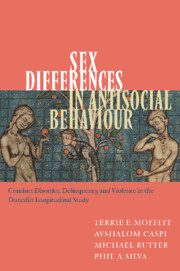 Sex Differences in Antisocial Behaviour
Sex Differences in Antisocial Behaviour Published online by Cambridge University Press: 22 September 2009
Chapter 3 revealed that more males than females engage in antisocial behaviours, and males engage in more antisocial behaviours than females. It also revealed that males' antisocial behaviours relative to females' were more likely to be serious and committed persistently at a high rate. The possible exception was drug-and alcohol-related activities, on which girls resembled boys, especially near age 15. In contrast to the continuously distributed measures of antisocial behaviour examined in the previous chapter, this chapter compares the sexes on categorical measures: diagnoses of antisocial disorder. The criteria for a diagnosis of conduct disorder are intended to capture behaviours that are serious and committed persistently at a high rate. Behaviours related to drugs and alcohol are excluded from the criterion list. Therefore, we would expect to find sex differences in diagnoses that are as large as, if not larger than, the sex differences we saw in chapter 3's continuous measures of antisocial behaviours.
A review of the five epidemiological studies that reported DSM-III (American Psychiatric Association, 1980) diagnoses of childhood disorders concluded that across all five studies more boys than girls had conduct disorder, despite marked differences between studies in the age range of children studied, nationality, reporting sources, and procedures followed to convert the symptoms assessed into diagnostic categories (Costello, 1989). Epidemiological studies conducted using DSM-III-R (American Psychiatric Association, 1987) and ICD-10 definitions in the 1990s agree (Lahey et al., 2000; Lewinsohn et al., 1993; Offord et al., 1996; Simonoff et al., 1997; Verhulst et al., 1997).
To save this book to your Kindle, first ensure [email protected] is added to your Approved Personal Document E-mail List under your Personal Document Settings on the Manage Your Content and Devices page of your Amazon account. Then enter the ‘name’ part of your Kindle email address below. Find out more about saving to your Kindle.
Note you can select to save to either the @free.kindle.com or @kindle.com variations. ‘@free.kindle.com’ emails are free but can only be saved to your device when it is connected to wi-fi. ‘@kindle.com’ emails can be delivered even when you are not connected to wi-fi, but note that service fees apply.
Find out more about the Kindle Personal Document Service.
To save content items to your account, please confirm that you agree to abide by our usage policies. If this is the first time you use this feature, you will be asked to authorise Cambridge Core to connect with your account. Find out more about saving content to Dropbox.
To save content items to your account, please confirm that you agree to abide by our usage policies. If this is the first time you use this feature, you will be asked to authorise Cambridge Core to connect with your account. Find out more about saving content to Google Drive.